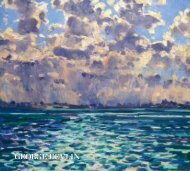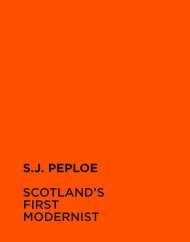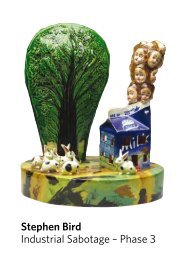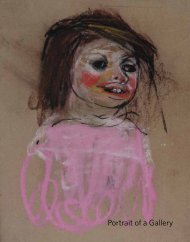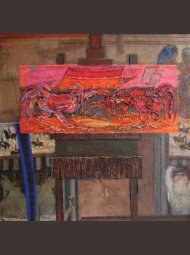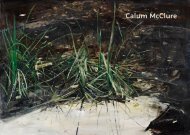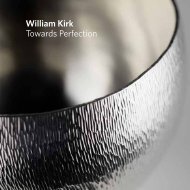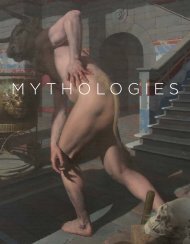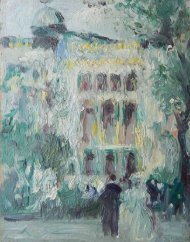Download a PDF of the exhibition catalogue - The Scottish Gallery
Download a PDF of the exhibition catalogue - The Scottish Gallery
Download a PDF of the exhibition catalogue - The Scottish Gallery
Create successful ePaper yourself
Turn your PDF publications into a flip-book with our unique Google optimized e-Paper software.
Very little information is available concerning <strong>the</strong> movement <strong>of</strong> pictures between<br />
<strong>the</strong> Kirkcaldy Art <strong>Gallery</strong> and Wilby House. One document, dated 1962, lists <strong>the</strong><br />
paintings under room headings and shows that <strong>the</strong>y were largely organised as ‘one artist<br />
to one room’. Essentially McTaggarts were hung in <strong>the</strong> dining room, Sickerts in <strong>the</strong><br />
drawing room, Wingates in <strong>the</strong> sitting room, a mix in <strong>the</strong> hall and stair, and Peploes<br />
dominated <strong>the</strong> master bedroom. <strong>The</strong>re were five bedrooms in all: <strong>the</strong> first was entirely<br />
devoted to Peploe, <strong>the</strong> second to McTaggart’s smaller works, and <strong>the</strong> third, fourth and<br />
fifth bedrooms were decorated by a selection <strong>of</strong> works by different artists. Still-lifes were<br />
put next to portraits and landscapes. Little importance was given to <strong>the</strong> dates <strong>of</strong> pictures<br />
in relation to <strong>the</strong> positioning in <strong>the</strong> house; as has been mentioned, Blyth did not keep a<br />
record <strong>of</strong> <strong>the</strong> dates <strong>of</strong> his pictures, and <strong>the</strong>refore we can assume that <strong>the</strong>y were relatively<br />
unimportant to him.<br />
<strong>The</strong> 1962 list indicates that 114 works were hanging in Wilby House and 123<br />
in <strong>the</strong> Kirkcaldy Art <strong>Gallery</strong>. It does not give any indication as to why certain pictures<br />
went to <strong>the</strong> <strong>Gallery</strong>, while o<strong>the</strong>rs remained in Wilby House. It does however show that<br />
<strong>the</strong> <strong>Gallery</strong> was very much representative <strong>of</strong> <strong>the</strong> collection: all <strong>the</strong> phases, developments<br />
and artists represented in Wilby House were also evident to a greater or lesser extent<br />
in <strong>the</strong> <strong>Gallery</strong>, and in no way are <strong>the</strong> works in <strong>the</strong> Kirkcaldy <strong>Gallery</strong> inferior to those<br />
in Wilby House. For example, <strong>The</strong> Waves by McTaggart, Blyth’s favourite picture, was<br />
hanging in <strong>the</strong> <strong>Gallery</strong> at this date. <strong>The</strong> lighting in <strong>the</strong> new <strong>Gallery</strong> was particularly good<br />
and certainly better than at Wilby House: <strong>the</strong> <strong>Gallery</strong> picture rooms were illuminated by<br />
<strong>the</strong> topside lighting principle, a system which reduces reflection to a minimum.<br />
Margery Blyth remembered a constant coming and going <strong>of</strong> pictures between<br />
house and <strong>Gallery</strong>. What is most likely is that, having divided his home up into rooms<br />
representative <strong>of</strong> <strong>the</strong> four major artists in his collection along with o<strong>the</strong>r ‘mixed’ rooms,<br />
Jack Blyth could have kept a flow <strong>of</strong> works, regularly refreshing both <strong>the</strong> <strong>Gallery</strong> and<br />
Wilby House with new examples. Moreover, he felt responsible to keep a representative,<br />
non-repetitive selection for <strong>the</strong> collections in <strong>the</strong> <strong>Gallery</strong> for <strong>the</strong> public eye in order to<br />
maintain <strong>the</strong> status and popularity <strong>of</strong> <strong>the</strong> <strong>Gallery</strong>.<br />
Blyth was always generous about loans to <strong>exhibition</strong>s, not surprisingly taking<br />
<strong>the</strong> view that lending was a duty and <strong>the</strong> availability <strong>of</strong> great art to <strong>the</strong> general public a<br />
public good.<br />
In August 1956 an <strong>exhibition</strong> <strong>of</strong> selected modern <strong>Scottish</strong>, English and French<br />
paintings in <strong>the</strong> Blyth Collection was held by <strong>the</strong> <strong>Scottish</strong> Arts Council at Ro<strong>the</strong>say<br />
Terrace in Edinburgh. <strong>The</strong> display was made up <strong>of</strong> only 25 pictures by 13 different<br />
artists and is <strong>the</strong> only <strong>exhibition</strong> representative <strong>of</strong> <strong>the</strong> Blyth Collection to have been held<br />
until now.<br />
21




